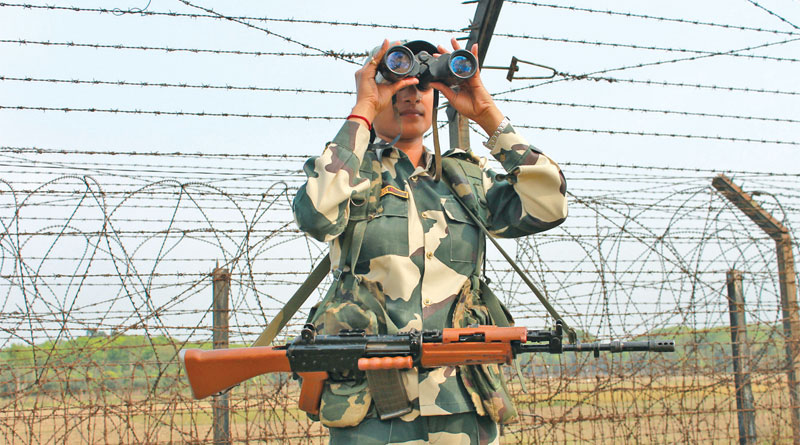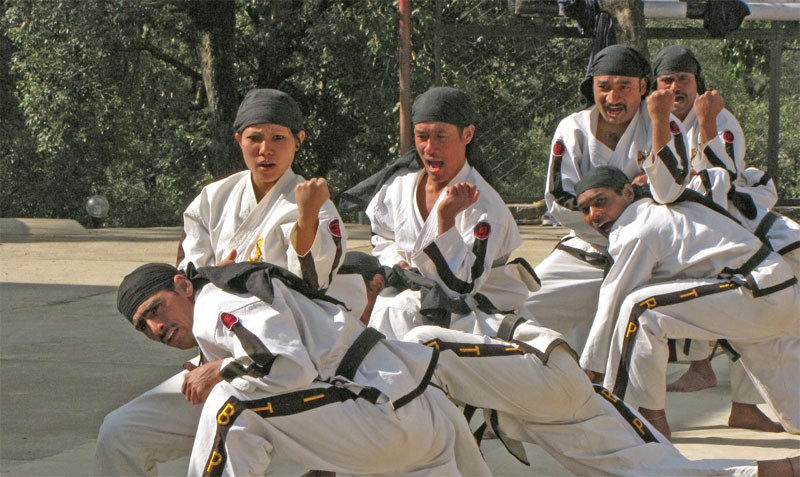The breadth of internal security challenges demands a re-evaluation of existing policies
Tushar Srivastava
Post-independence India has been beset by several internal security problems. The successive governments have had to put in a lot of effort to put down many separatist fires including that in Kashmir which continues to drain India both in financial and human resources.

Until a few decades ago, the government was also engaged in controlling multiple insurgencies in the Northeast, some of which started right after independence. The Naga problem still need closure. Separatism/ militancy aided and abetted by Pakistan raged in Punjab through 1980s and early-1990s imposing heavy cost in terms of lives and economy. It was finally resolved by political sagacity of the leaders of the day. The Maoist insurgency in central India, referred to as the most serious threat to internal security by Prime Minister Manmohan Singh, continues to bleed our resources.
Each of these movements/ problems have been the consequence of several disparate factors, ranging from economic disparities to real or perceived social discrimination. While in the border areas, financial and logistic support by our inimical neighbours have compounded these problems, in Central India, the tribal marginalisation from the mainstream has been exploited by Left-wing extremism.
The central armed forces often referred to as Central Paramilitary Forces (CPMF) are the mainstay of the national effort to bring down violence in these troubled areas. The quantum and spread of these problems have led to rapid expansion of these forces and their strength now is in the region of one million personnel i.e., about 60 per cent of the strength of the defence forces. The most remarkable rise of the paramilitary forces has been in the domains of border security, counter insurgency, industrial security and riot control.
The Force Formation
There are seven central armed forces. Five of these, Central Reserve Police Force (CRPF), Border Security Force (BSF), Indo Tibetan Border Police (ITBP), Sashashtra Seema Bal (SSB) and Central Industrial Security Force (CISF) operate under the ministry of home affairs (MHA). Assam Rifles (AR), though funded by the MHA operates under the command of the ministry of defence (MoD). The Rashtriya Rifles (RR), which is an adjunct of the Indian Army, also operates as an anti-insurgency force under the MoD. The RR is now learnt to have been deployed on the India-China border after the trouble in eastern Ladakh.
Different states, depending upon their internal security challenges, have raised their own state armed police battalions. Their task is to assist the police when required. Some specialised forces, say, Andhra Pradesh’s Greyhounds raised specifically for LWE, operate independent of the police. A few states have also raised their own ‘Special Task Forces’ (STF) and ‘Special Operations Groups’ (SOGs) for specific operations. The central government has also sanctioned India Reserve Battalions (IRB) for many states for national duties in case of requirement.
The raising of the central armed forces has relieved the defence forces of the burden of internal security to a large extent. Though, they continue to be engaged in internal security in Jammu and Kashmir and certain parts of the Northeast.
Historically speaking, internal security in pre-independent India was the responsibility of the colonial army, though sparingly used in the 20th century. There were very few armed forces other than the colonial army, namely Cachar Levy (later Assam Rifles) in the east and Punjab Frontier Force in the west. Free India inherited the provincial constabularies and the Crown’s Representative Police Force (raised in 1939), later renamed as CRPF after independence.
The first spurt in post-independence growth of paramilitary forces occurred in the 1960s in response to external, rather than internal, threats. The threat from China led to the raising of the ITBP in 1962. The world’s largest border guarding force, the BSF, was raised after the 1965 war with Pakistan to guard India-Pakistan border (now India-Pakistan and India-Bangladesh borders). The SSB was raised in 2001 for guarding India-Nepal and India-Bhutan borders.
In addition to their primary role, the border guarding forces also have a secondary role in internal security as aid to civil administration, in addition to being requisitioned for election duties in various parts of India. The BSF has performed a stellar role in combating insurgencies in Nagaland and other north-eastern states where it was the leading paramilitary. It also helped in effectively controlling the Gorkhaland agitation in the 1980s and the early 1990s. The BSF made phenomenal contributions in combating militancy in Punjab and J&K until 2003. Thereafter, it was de-inducted after the government decided to designate CRPF as the main internal security force of the country by adopting the principle of ‘One Task One Force’. This was recommended by the Group of Ministers committee set-up after the 1999 Kargil war.
However, given the enormity of the internal security challenges, the BSF is once again deployed in central India against the Maoist insurgency. Even the ITBP, besides border duties, is used for providing close protection to political leaders and government officials targeted by rebels. Like the BSF, ITBP is also deployed in central India for combating Maoist insurgency.
The CRPF, established essentially for internal security has honed riot & crowd control and counter insurgency capabilities. Through the 1980s and 1990s, the CRPF became a mobile force, reconstituting its riot control squads into Rapid Action Force. The CRPF has also raised ‘Combat Battalion for Resolute Action’ (COBRA) units for special operations in the LWE areas. In Punjab, the CRPF served effectively at the height of the Khalistan movement. After the successful end of militancy in Punjab, CRPF reverted to riot and crowd control, while continuing limited counter insurgency operations in north-eastern region. As stated above, in 2004 the CRPF replaced the BSF in J&K and is presently the main counter insurgency force there besides the Rashtriya Rifles. It is also heavily deployed in Maoist-affected Central India.

The Challenges Ahead
As discussed above, the central armed forces have been involved in combating many insurgencies. Besides those, they have also been assigned several other responsibilities. For instance, they were involved in controlling the Indian railways strike in early 1979. They were tasked to ensure smooth operations of the trains besides ensuring peace and tranquillity in the railway estates. They have helped quell communal riots at many places including in Bombay, Bhagalpur, Moradabad and Ahmedabad.
Despite numerical growth, the central armed forces remain overstretched because of the compulsions of their widespread deployment throughout the country. Prolonged deployment wrecks the personnel management systems by disrupting the training and leave schedule of troops resulting in dilution of operational efficiency thereby causing stress to both troops and commanders. The states have started requisitioning these forces even at the hint of a smallest law and order problem even though these may be well within the capability of the local police. Similarly, requisitioning of these forces for even Panchayat elections puts a heavy burden on them.
The state governments and police leadership must initiate measures for capacity-building of the state police and armed police forces to reduce their dependence on the central armed forces.
The central armed forces face another dilemma while performing their duties. All the forces are equipped with firearms. Only the CRPF has a component equipped with lathis. Their training methodology is ‘Ek Goli Ek Dushman’, whereas in dealing with internal security they are expected to adhere to the principle of ‘minimum force’. These forces therefore are often at the receiving end of brickbats for human rights violation. Most forces have tried to adapt to these requirements by including soft skills in their training. The forces are also increasingly using less lethal methodology while operating in populated areas to avoid collateral damage.
However, in insurgency-affected areas, they cannot be expected not to resort to use of firearms against armed militants. Right to private defence takes precedence under these circumstances. The leaders of the force therefore must train their personnel in both aspects. The training should also orient itself towards producing confident and independent junior leaders capable of taking decisions quickly and seizing the initiative from the adversary. The troops and junior leaders must be adept at basic drills for countering different challenges.
The forces also confront several operational and logistics problems when deployed for internal security duties. Not being familiar with the terrain and the societal mores, they are handicapped. Therefore, most important for the leaders of the force is to carry out familiarisation training whenever new set of troops are inducted in a particular area. This familiarisation process will also obviate another problem that the troops face—getting actionable information. Good liaison with the state police would help resolve the problem of lack of intelligence.

Another operational problem that the forces face, especially in areas where AFSPA is not in force, is the non-availability of police for conduct of operations. Since under the CrPC, the central armed forces do not have the power to carry out search operations on their own, they need the local police representative of appropriate level to accompany them while conducting such operations to avoid subsequent legal complications.
The central armed forces face additional constraints while operating in internal security environment. First of this relates to the organisational hierarchy of the forces. These forces operate in sub-units and units like sections, platoons, companies and battalions and move with their command elements, whereas the police, used to operating in ones and twos, prefer the forces to be placed directly under its command for deployment as deemed fit by it. For this reason, it does not want the command elements of the forces. This, coupled with the police’ lack of understanding of the ethos of the armed forces leads to lack of coordination. Conversely, the armed forces’ lack of knowledge of the constraints of the police too adds to the difficulties. The coordination at the local level is therefore personality based rather than system based.
The one-upmanship, hunger for credit etc are some other aspects which hinder the efficiency of these forces while operating in internal security. Poor logistics support from the states, especially accommodation which more often is substandard, only compounds the problem.

Conclusion
Certain actions, like creation of unified command consisting of representatives of all agencies involved, will help in better coordination, quick dissemination of information and tying up of minute details besides ironing out differences. Creation of a security grid like the one existing in Maoist-affected central India, more and effective technical gadgets for intelligence gathering and surveillance are some other suggested measures.
Familiarisation training of troops prior to induction, apart from focusing on physical fitness, must also cater for extensive physical patrolling of the area in conjunction with outgoing troops to know the terrain. Troops should also be educated to respect the social mores of locals to understand them better. Case studies, especially the ones involving setbacks will enable comprehension of modus operandi of militants/ insurgents and enable analysis of threats and preparation of a domination plan. At higher levels, the commanders must familiarise themselves with the complexities of the prevailing situation.
The central armed forces have an important role in assisting the civil administration in dealing with internal security situations. They must therefore always be in operational readiness to undertake these tasks. Proper coordination with police authorities and orientation of training for these tasks will go a long way in enhancing efficiency of these forces in conduct of internal security operations.

